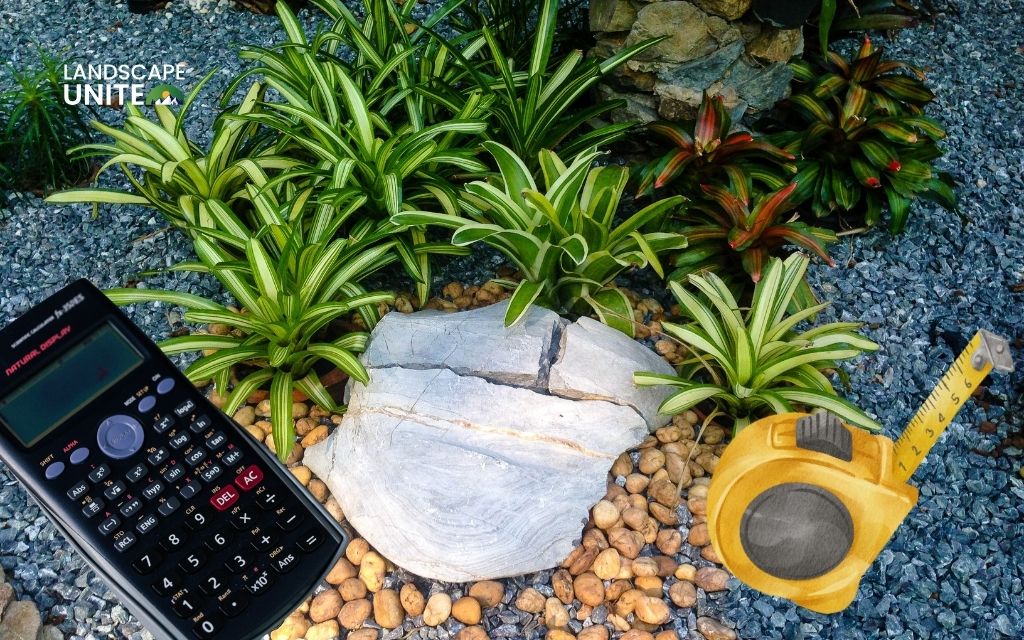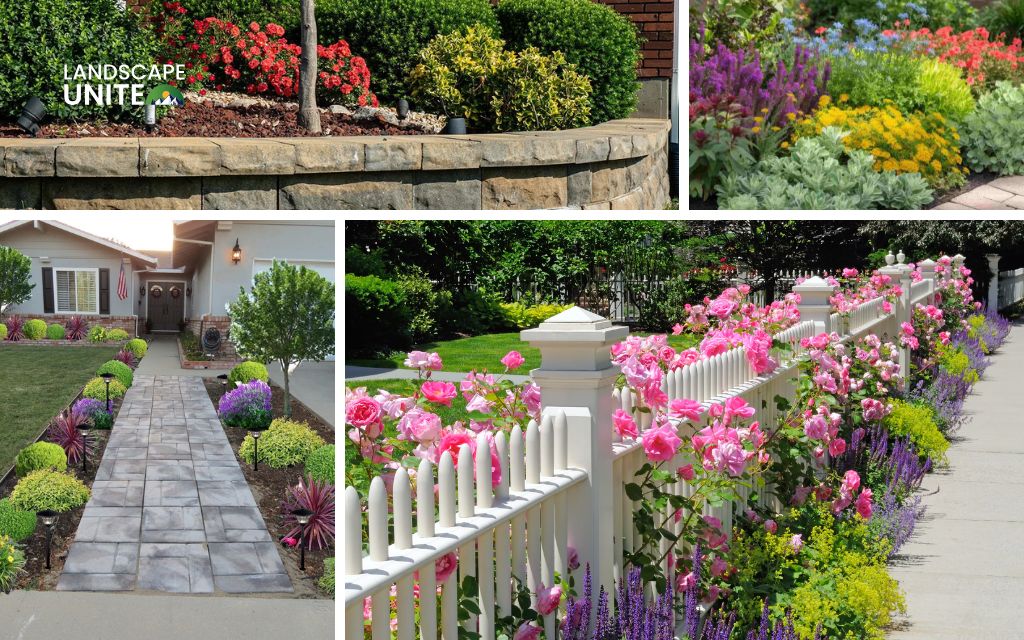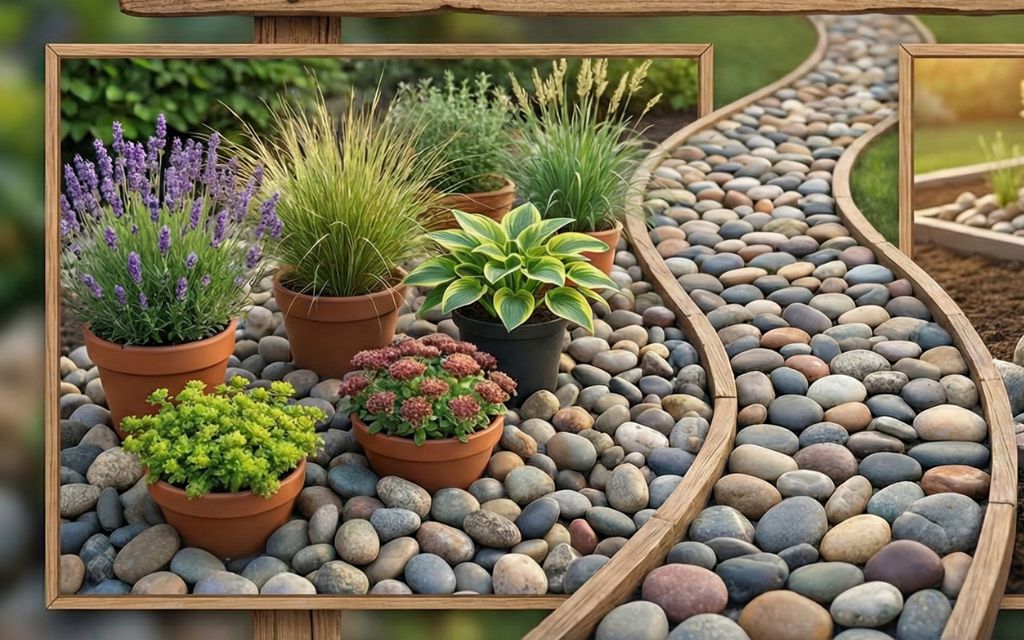The beauty of hydrangeas lies in their versatility. They work equally well anchoring a formal foundation planting or spilling romantically over a cottage garden fence. They’ll brighten the shadiest corners of your yard while certain varieties bask happily in full sun. And perhaps best of all, once established, they’re remarkably low-maintenance.
In this comprehensive guide, we’ll walk through 14 inspiring ideas for landscaping with hydrangeas, share expert insights on selecting the right varieties and provide practical advice to ensure your hydrangea garden thrives for years to come.
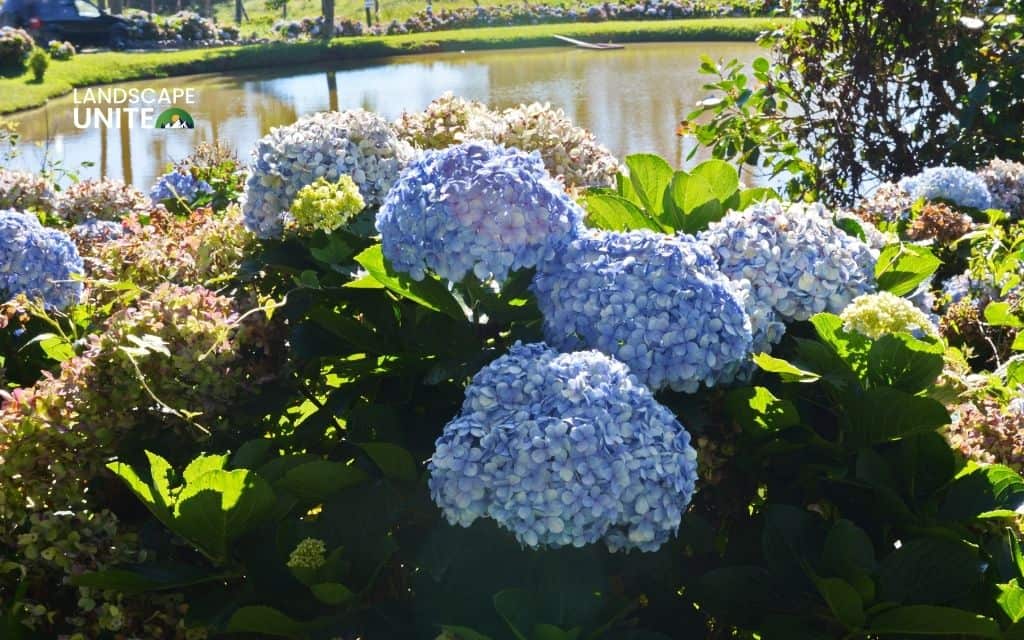
Best hydrangea varieties for landscaping
Choosing the right hydrangea variety for your specific conditions ensures success. Here’s a breakdown of the major types:
Bigleaf Hydrangeas (H. macrophylla)
These are the classic hydrangeas with large, round mophead or flat lacecap flowers.
They’re the varieties whose color you can manipulate through soil pH – acidic soil produces blue blooms, while alkaline soil creates pink flowers. Best for zones 5-9, they prefer morning sun and afternoon shade.
Popular varieties include Endless Summer, Nikko Blue, and Twist-n-Shout.
Panicle Hydrangeas (H. paniculata)
The most sun-tolerant and cold-hardy hydrangeas, panicle types produce cone-shaped flower clusters that emerge white and often mature to pink. They bloom on new wood, making spring pruning straightforward.
Thriving in zones 3-8, they tolerate full sun to partial shade. Top picks include Limelight, Pinky Winky, and Quick Fire.
Smooth Hydrangeas (H. arborescens)
Native to eastern North America, smooth hydrangeas like Annabelle produce enormous white blooms on new wood, making them cold-hardy (zones 3-9).
They prefer partial shade and consistent moisture. The newer Incrediball variety offers even larger blooms on stronger stems.
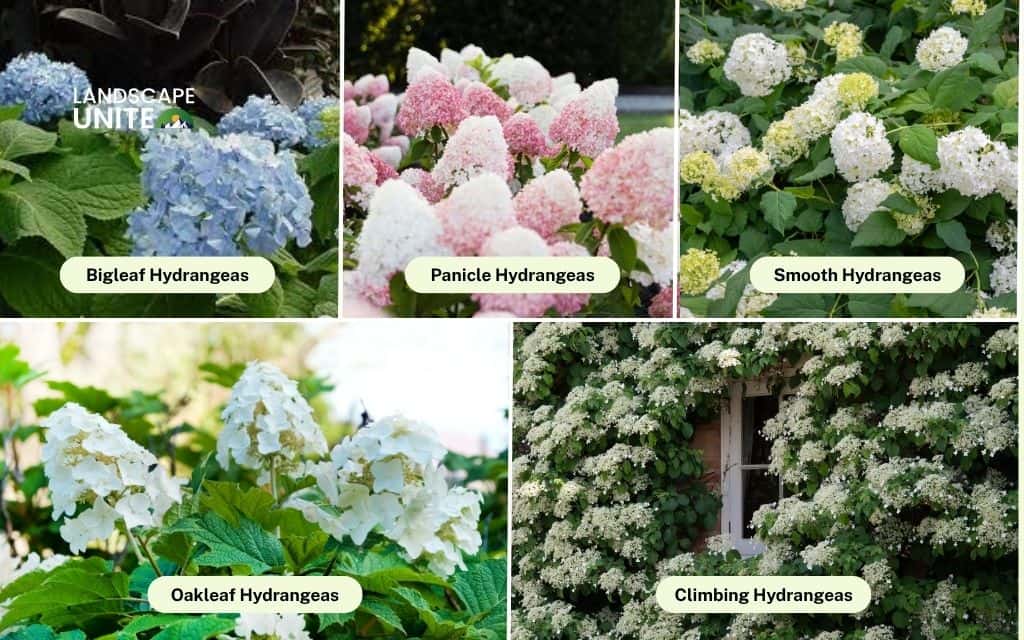
Oakleaf Hydrangeas (H. quercifolia)
Named for their distinctive oak-shaped leaves, these hydrangeas offer fall foliage color and exfoliating bark for winter interest. White cone-shaped flowers appear in early summer and fade to antique roses.
They’re ideal for shade to partial sun in zones 5-9. Varieties like Snow Queen and Alice provide excellent ornamental value beyond just flowers.
Climbing Hydrangeas (H. petiolaris)
A unique vine form that clings to structures via aerial rootlets. It produces flat-topped white flowers in early summer and tolerates shade better than most flowering vines.
Hardy in zones 4-8, climbing hydrangeas are slow to establish but become spectacular specimens. Perfect for north-facing walls or shaded arbors.
14 stunning ideas for landscaping with hydrangeas
Frame your front door with hydrangeas
Nothing says “welcome home” quite like symmetrical plantings flanking your entry. Positioning hydrangeas on both sides of your front door creates an inviting focal point that softens architectural lines while adding sophisticated polish to your curb appeal.
For this classic approach, choose varieties that maintain a rounded, compact form. Endless Summer hydrangeas deliver reliable reblooming throughout the season, Blushing Bride offers pristine white blooms that complement any home exterior. If you’re working with a grander entrance, PeeGee hydrangeas provide substantial height and structure.
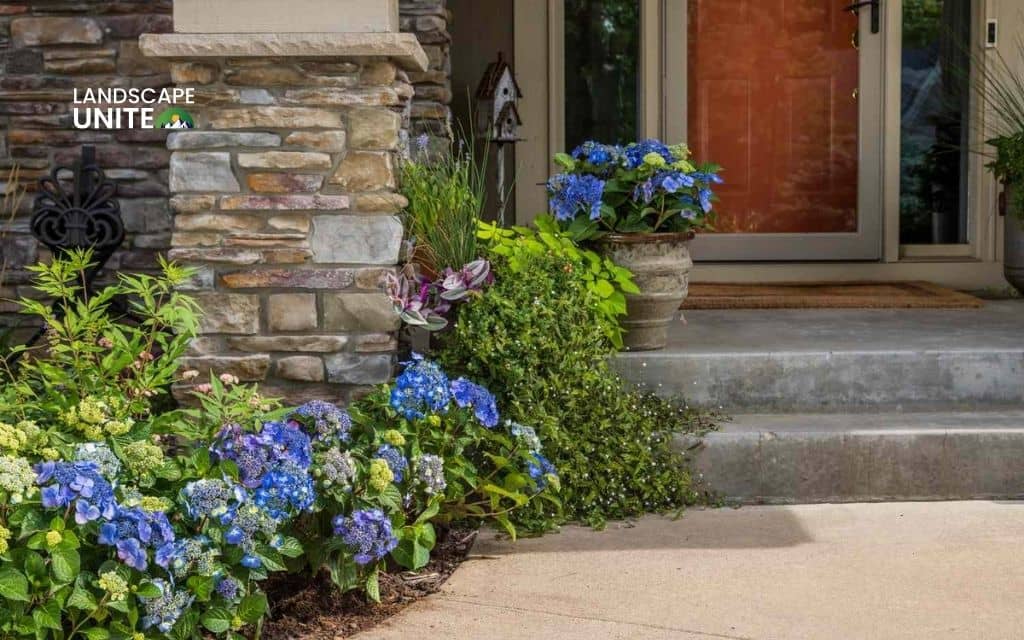
Border your walkways with hydrangeas
Transform an ordinary path into a floral promenade by lining walkways or driveways with compact hydrangea varieties. This approach guides visitors through your landscape while creating a cohesive, designed look that elevates the entire property.
Hydrangea paniculata ‘Little Lime’ stays petite while delivering those signature lime-green blooms that mature to pink. Bobo hydrangeas max out around three feet, making them ideal for maintaining clear sight lines and preventing the overgrown look.
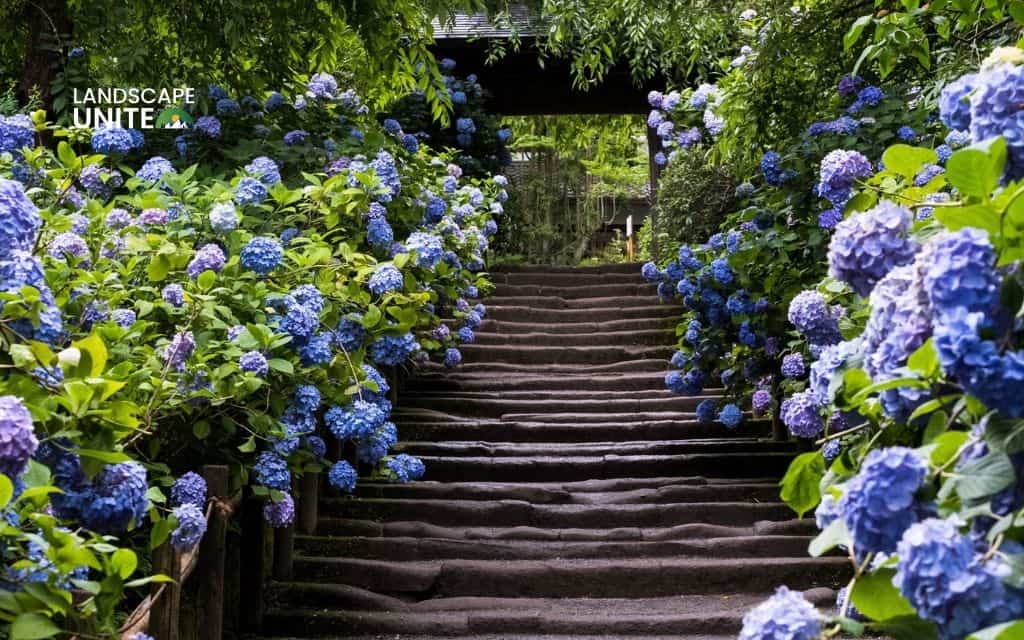
Design a hydrangea hedge for natural privacy
Why settle for boring evergreen hedges when you can have a blooming privacy screen? Hydrangea hedges offer seasonal flowers, fall color, and attractive winter structure – all while defining property lines or creating garden rooms within your landscape.
Limelight hydrangeas are the gold standard for hedging, reaching 6-8 feet with sturdy stems. Annabelle provides a softer, slightly shorter option with enormous white blooms, while Quick Fire delivers the earliest flowers of the season.
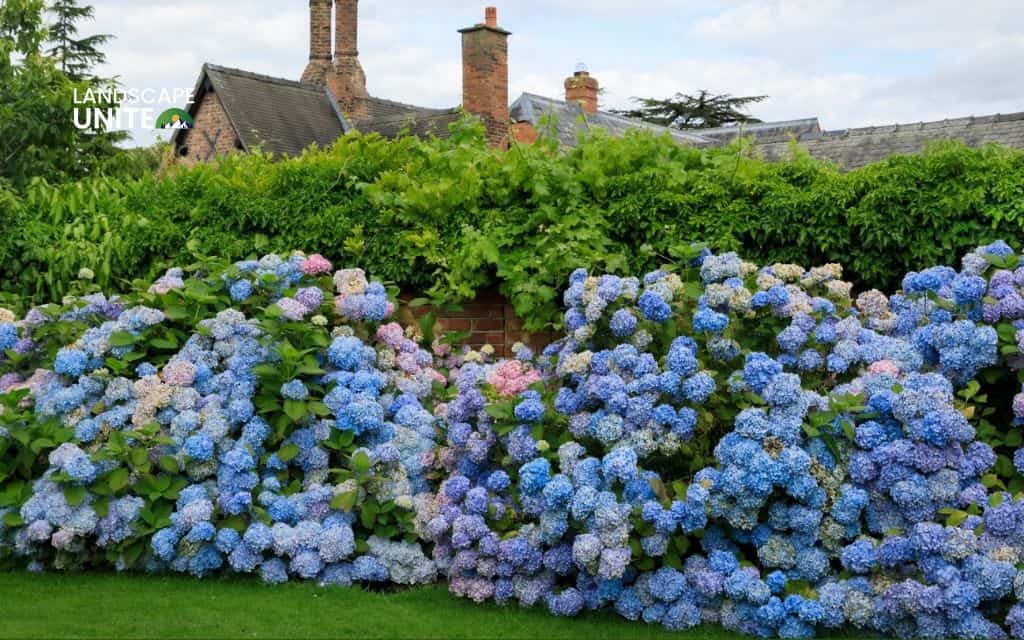
Mix hydrangeas with evergreen shrubs
One of the smartest strategies in landscape design is combining deciduous bloomers with evergreen structure. Pairing hydrangeas with boxwood, holly, or yew creates a foundation planting that looks intentional year-round, not just during summer bloom season. This combination works in front of homes where you need visual interest across all seasons.
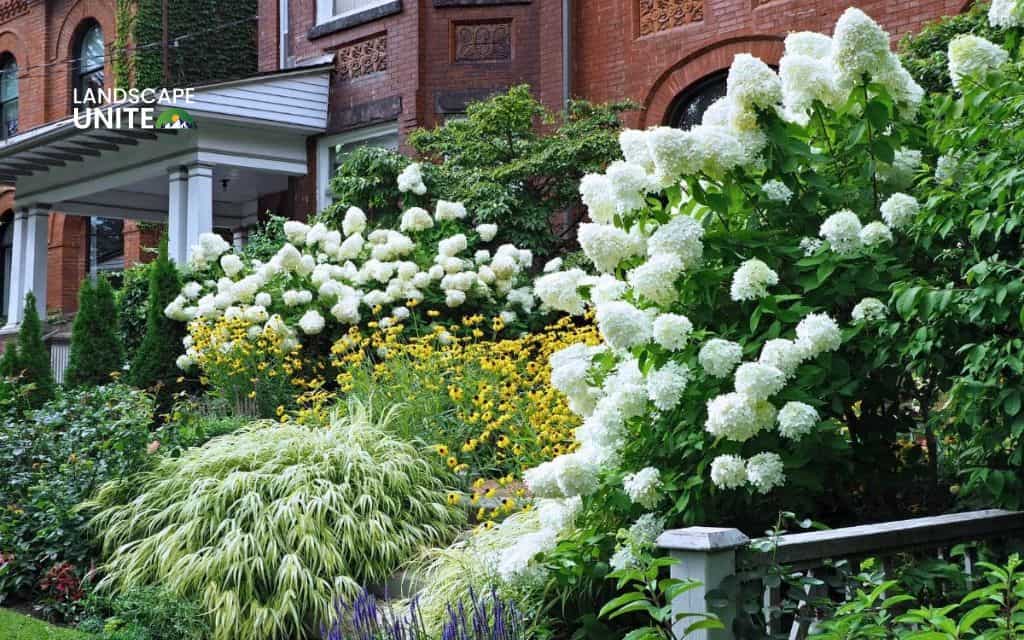
Create a cottage garden look
For gardeners drawn to romantic, informal landscapes, hydrangeas are essential players in the cottage garden aesthetic. Their abundant blooms and soft forms pair with traditional cottage plants like roses, peonies, and delphiniums.
Choose pastel-colored varieties to maintain the dreamy cottage vibe. Nikko Blue delivers those iconic blue blooms, Pinky Winky starts white and transitions to pink for extended interest. Layer heights by placing taller hydrangeas toward the back with shorter perennials cascading forward.
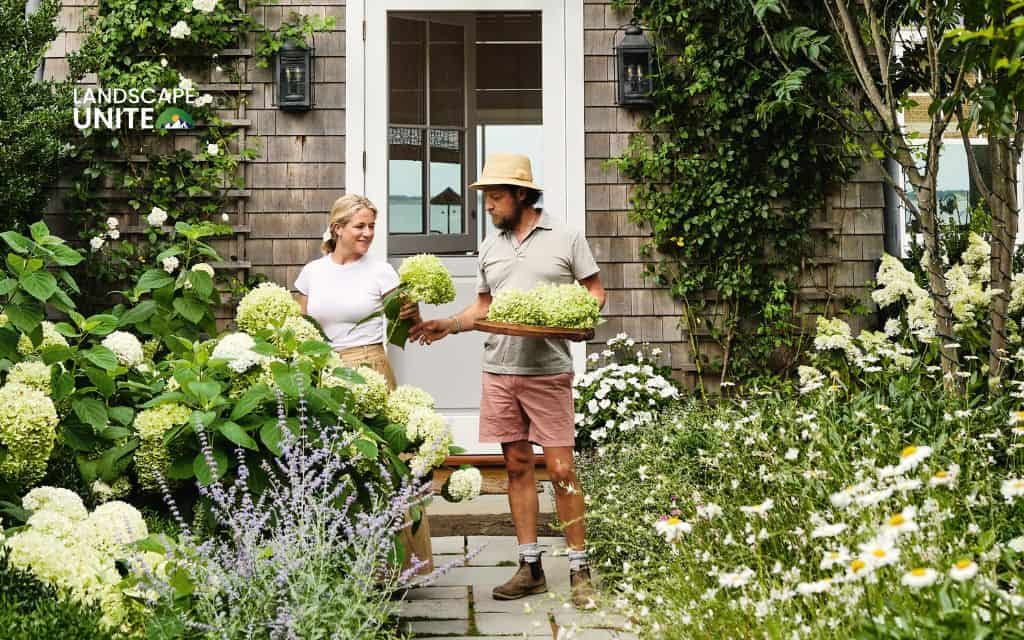
Use hydrangeas as a focal point
Every well-designed garden needs focal points that draw the eye and anchor the space. A hydrangea specimen planted in a central bed or island creates natural drama without requiring constant maintenance.
Surround your star player with supporting cast members like ornamental grasses, which add movement, or flowering perennials like Russian sage or coneflowers that extend the bloom season.
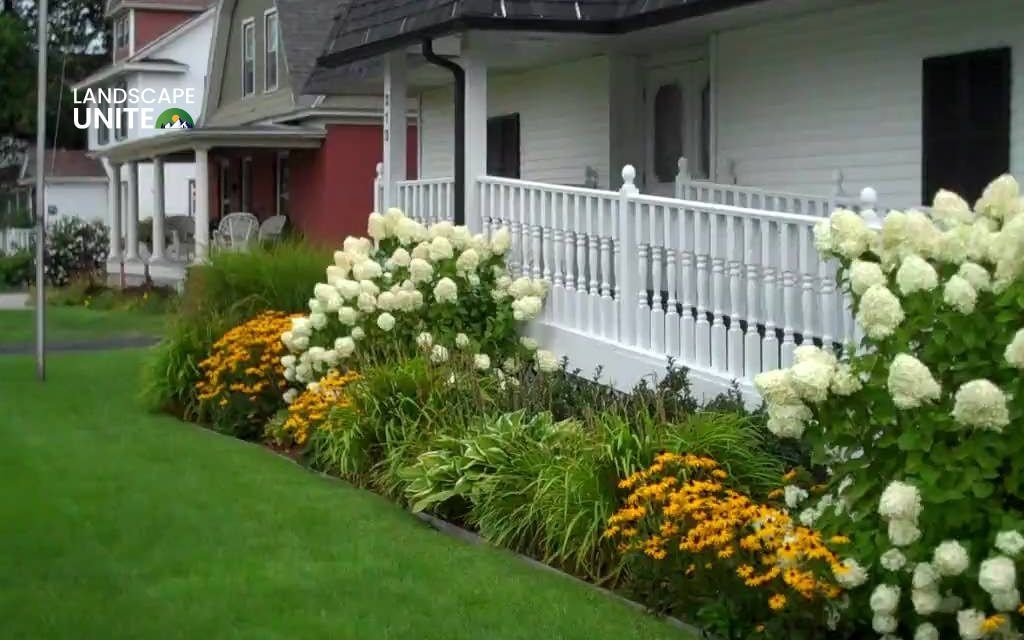
Brighten a shady corner
Hydrangeas actually prefer partial shade and will reward you with abundant blooms in conditions that stump other shrubs. Oakleaf hydrangeas are shade champions, tolerating deeper shade than most. Bigleaf hydrangeas (the classic mopheads and lacecaps) thrive in morning sun and afternoon shade, making them perfect for brightening eastern exposures or areas shaded by trees.
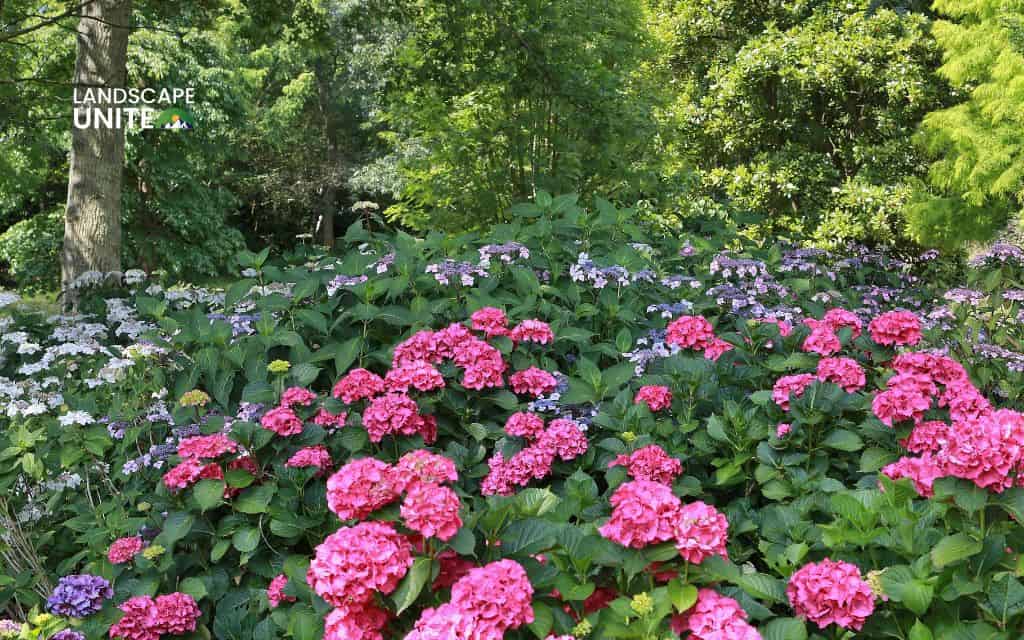
Combine with hostas and ferns
Speaking of hostas and ferns, pairing these classics with hydrangeas creates lush, layered plantings with incredible textural variety. This combination excels in woodland gardens or along shaded property boundaries.
Use hydrangeas as the vertical element, providing height and flower power, and hostas contribute bold foliage at mid-level and ferns add soft, fine texture throughout. Ferns soften everything and help tie the composition together.
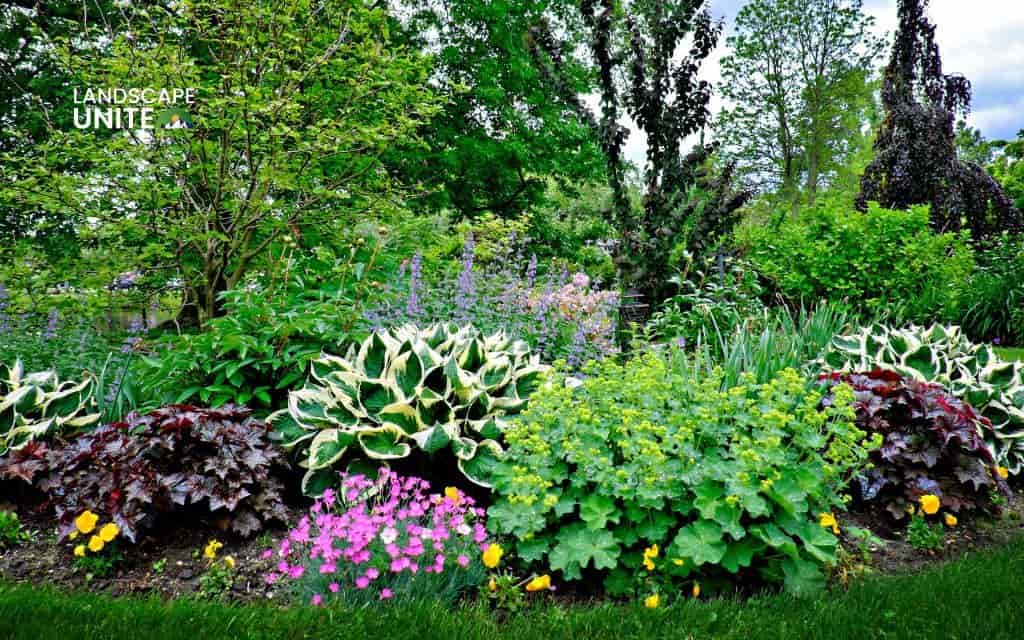
Accent garden structures
Pergolas, arbors, and patios benefit from the softening effect of nearby plantings. Positioning hydrangeas to frame or flank these structures creates the perfect marriage of hardscape and plants.
For ground-level plantings around structures, any upright hydrangea variety works well. But if you’re looking for something truly special, consider Climbing Hydrangea (Hydrangea petiolaris). This vine clings to walls, fences, or trellises, producing white flowers and adding vertical dimension to your landscape.
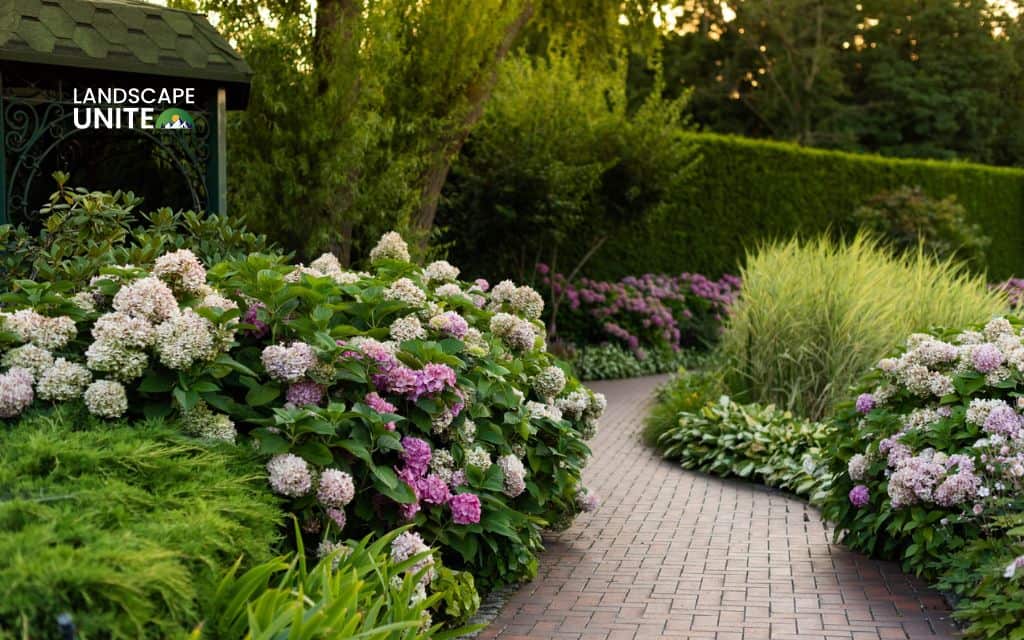
Design a dedicated hydrangea flower bed
Why not celebrate hydrangeas by giving them their own dedicated space? A hydrangea-focused bed allows you to group several varieties for layered height, sequential blooming, and a stunning display from June through October.
Start with taller varieties like Limelight or Pinky Winky at the back, mid-height selections like Annabelle in the middle, and compact varieties like Little Lime or Bobo along the front edge. This creates a tiered effect that showcases each variety and maintains visual flow.
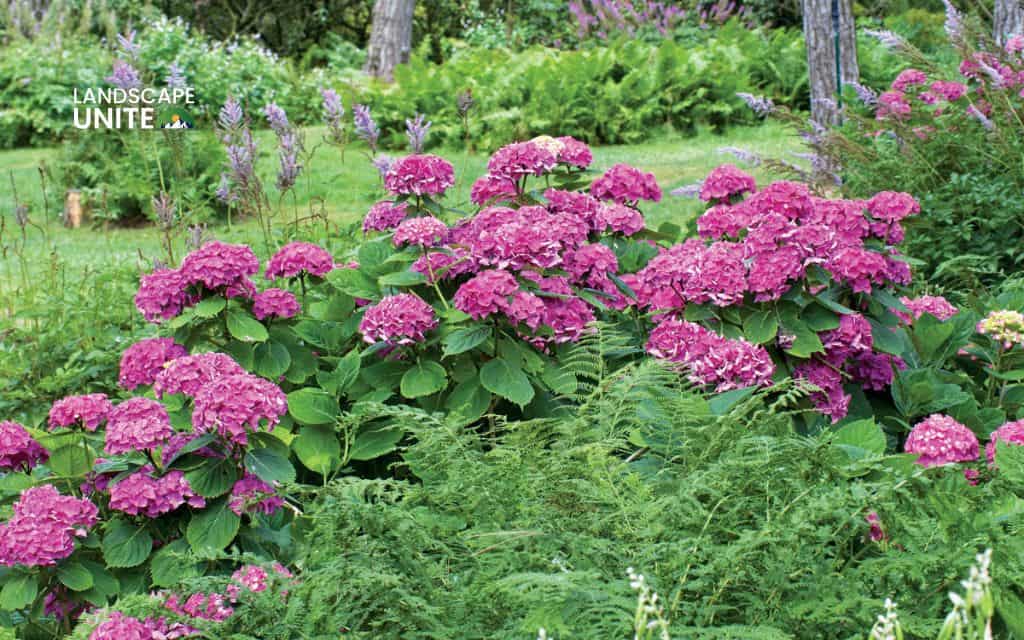
Mix colors for seasonal drama
One of the unique joys of landscaping with hydrangeas is their color-changing ability. By combining pink, blue, white, and lime varieties in a single planting area, you create a dynamic, evolving display that shifts throughout the growing season.
Understanding that soil pH affects bloom color in bigleaf hydrangeas opens up creative possibilities. You can even adjust pH in specific areas to manipulate colors, creating a truly customized color story in your landscape.
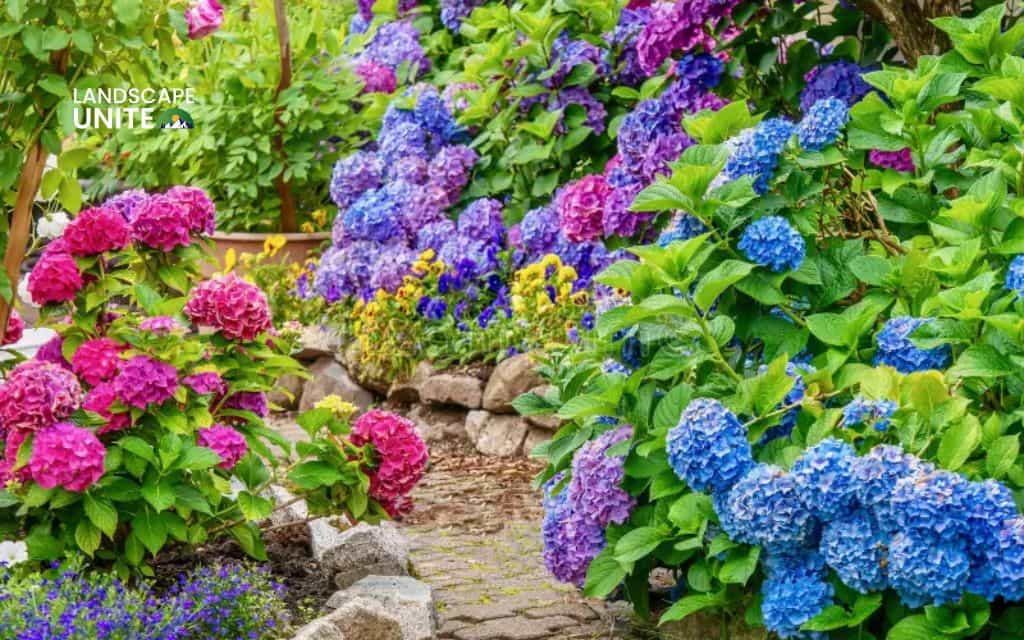
Add hydrangeas along a fence line
Fence lines often feel harsh and uninviting. Softening these boundaries with hydrangeas transforms them into attractive garden features.
Taller varieties work best for fence line plantings. PeeGee hydrangeas develop substantial size and tolerate more sun than other types, making them ideal for fence lines. Incrediball delivers massive white blooms on sturdy stems that don’t require staking even along windy fence lines.
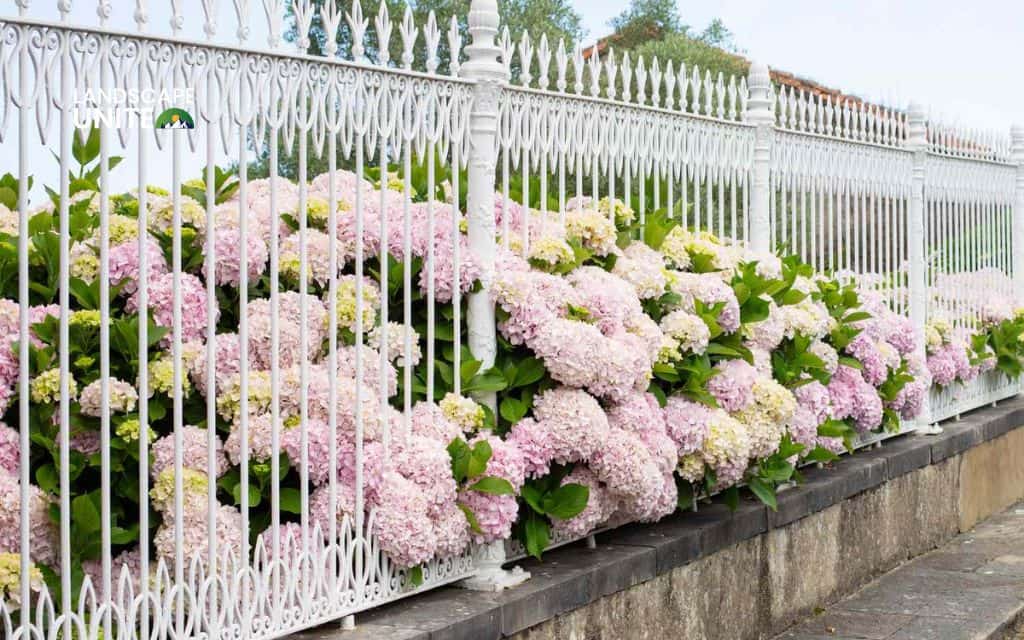
Use potted hydrangeas for patios and decks
Not every hydrangea needs to go in the ground. Container-grown hydrangeas offer flexibility for renters, condo dwellers, or homeowners who want to experiment with placement before committing to in-ground installation.
Mini Penny stays under two feet but produces full-sized blooms, and Cityline Paris offers excellent reblooming in a petite package. Choose containers at least 16 – 18 inches in diameter with drainage holes to prevent waterlogging.
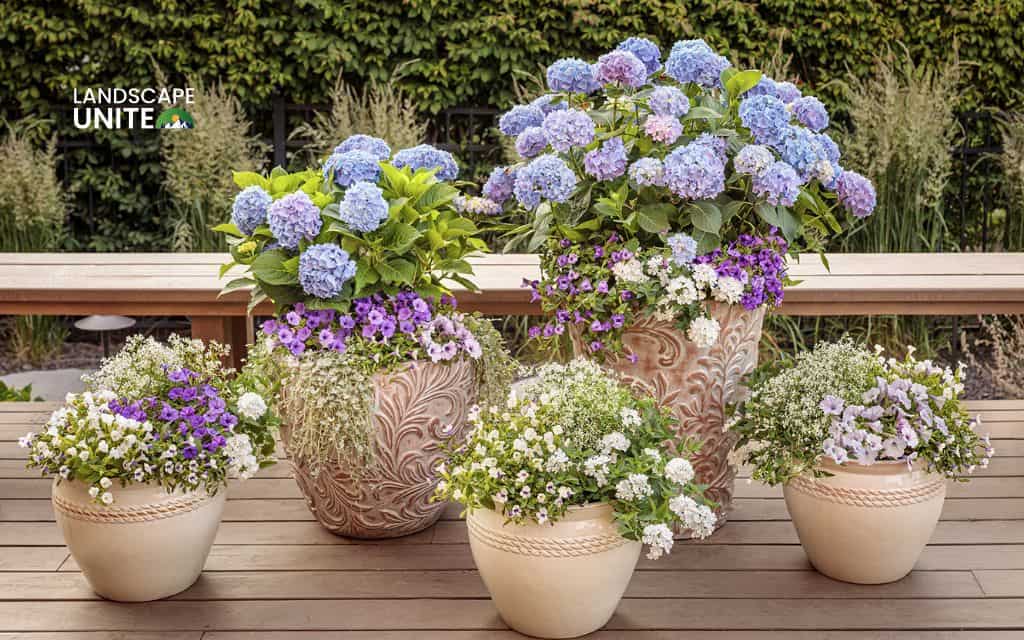
Create a hydrangea and ornamental grass border
For contemporary landscapes or properties with naturalistic designs, pairing tall panicle hydrangeas with ornamental grasses creates stunning textural contrast and movement. This pairing excels along property borders, driveway edges, or as a transitional planting between manicured lawn and naturalized areas. The combination requires minimal maintenance once established.
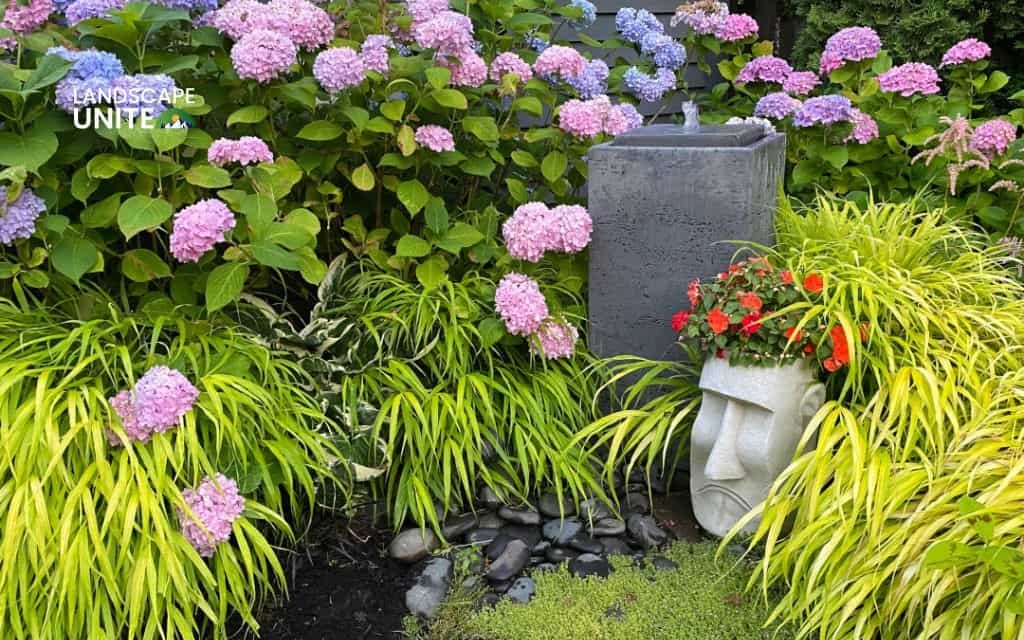
Benefits of landscaping with hydrangeas
Beyond their obvious beauty, hydrangeas deliver practical benefits that make them smart investments for any landscape:
Year-round visual interest
Hydrangeas aren’t one-season wonders. Summer brings spectacular blooms, fall delivers foliage color ranging from burgundy to gold, and winter reveals attractive branching structure and dried flower heads that catch snow beautifully.
Enhanced property value
Mature, well-placed hydrangeas significantly boost curb appeal and can increase property values. Real estate agents cite quality landscaping with shrubs like hydrangeas as features that help homes sell faster and for higher prices.
Low maintenance after establishment
While young hydrangeas need consistent watering, mature plants are remarkably self-sufficient. Most require only annual pruning (some varieties need none at all), occasional fertilizing, and watering during extended dry spells.
Pollinator magnets
Hydrangea blooms attract beneficial pollinators including bees, butterflies, and hummingbirds. Lacecap varieties are valuable to pollinators since their fertile central flowers provide accessible nectar and pollen.
Scalability
Whether you’re working with a compact urban lot or several acres, hydrangeas scale to fit. Dwarf varieties thrive in container gardens and small yards, while larger properties can accommodate sweeping hedges or mass plantings.
Essential care tips for thriving hydrangeas
Success with landscaping with hydrangeas requires understanding their basic needs:
- Planting location: Most hydrangeas prefer morning sun and afternoon shade, though panicle types tolerate more sun. Avoid hot, dry locations or deep shade. Ensure good air circulation to prevent disease but provide wind protection to prevent flower damage.
- Soil requirements: Hydrangeas thrive in rich, well-draining soil amended with organic matter. They prefer slightly acidic to neutral pH (5.5-7.0), though this affects flower color in bigleaf varieties. Conduct a soil test before planting.
- Watering schedule: Deep, consistent watering is crucial, especially during establishment and bloom periods. Provide at least one inch of water weekly, more during heat waves. Mulching helps retain moisture and regulate soil temperature.
- Fertilizing strategy: Feed in early spring as growth begins, using a balanced fertilizer or one formulated for hydrangeas. Avoid high-nitrogen fertilizers that promote foliage at the expense of blooms.
- Pruning practices: Pruning requirements vary by type. Bigleaf and oakleaf hydrangeas bloom on old wood, so prune after flowering. Panicles and smooth hydrangeas bloom on new wood, allowing for more aggressive spring pruning.
- Winter protection: In colder zones, protect bigleaf hydrangeas by applying extra mulch after the ground freezes and creating windbreaks with burlap screens. Panicles and smooth hydrangeas typically need no winter protection.
Conclusion
Landscaping with hydrangeas delivers a combination of stunning visual impact and straightforward maintenance.
These versatile shrubs adapt whether you’re framing an entrance, creating privacy screens, or designing dedicated flower beds. The 14 ideas in this guide give you proven approaches for every landscape style and space size.
With basic care and smart placement, your hydrangea landscape will deliver magazine-worthy beauty season after season, enhancing both your property value and outdoor living experience.
Ready to take your hydrangea landscape to the next level? Browse our garden knowledge library for in-depth guides on soil preparation, pruning techniques, and seasonal care schedules.
Frequently asked questions (FAQs)
Do hydrangeas prefer sun or shade?
Most hydrangeas thrive with morning sun and afternoon shade (4-6 hours of sunlight). Panicle hydrangeas tolerate full sun, while oakleaf varieties prefer shadier conditions. Match your variety to your site’s light conditions for best results.
What is the best time to plant hydrangeas?
Early spring or fall are ideal – spring allows full-season establishment, while fall offers warm soil and cooler air. Avoid planting during summer heat or winter freezes.
How do I change the color of the hydrangea?
Only bigleaf hydrangeas change color based on soil pH. Acidic soil (pH below 6) produces blue blooms; alkaline soil (pH above 7) creates pink flowers. Apply aluminum sulfate for blue or garden lime for pink. White varieties stay white regardless of pH.
How often should I water hydrangeas?
Water deeply once or twice weekly, providing about one inch of water. Increase frequency during heat waves – wilting leaves indicate water stress. Container plants need more frequent watering, often daily in hot weather.
Which hydrangeas are best for front yard landscaping?
Annabelle delivers reliable white blooms and cold hardiness. Limelight provides height and sun tolerance with lime-to-pink flowers. Endless Summer offers continuous reblooming from June through fall. For compact spaces, choose Little Lime or Bobo varieties.
